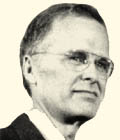
Backus, John Warner (1924 - 2007)
John Backus was born on 3 December 1924 in Philadelphia, although he spent his childhood in Wilmington. He came from a well-to-do family and attended the prestigious Pottstown School, Pennsylvania. He was not, however, a good student and admits that he hated studying.
Bt his parents’ behest, he enrolled at Virginia University to study chemistry, where again he underachieved.
The Second World War crossed his path, and he left university to enlist in the United States Army. There he received medical training and started to work as an operating room assistant at Atlantic City hospital, where he was diagnosed with a brain tumour. A steel plate was fitted in his head. Although he initially liked medicine, he gave it up nine months later because of all the information he had to memorize.
Aimless again, he travelled to New York, where he rented an apartment. He enrolled in an academy to train as a hi-fi radio technician, because, he said, “I like music”.
He found the mathematical principles of electronics easy to understand and liked the subject. Now that he had discovered something that interested him, he went to Columbia University to study mathematics and graduated in 1949. Not long before he graduated, he visited the IBM Computer Center on Madison Avenue, where he fell in love with what he saw. He immediately told the visit guide that he was looking for work, and she encouraged him to talk to a manager. Although, for a start, the manager did not want to receive him because he was dressed untidily and had a dishevelled look, Backus insisted and was finally granted an interview and was hired.
For his first three years at IBM, he worked as a programmer on the SSEC (Selective Sequence Electronic Calculator) project. SSEC was one of IBM’s first electronic computers.
IBM’s new computer, IBM 704, was designed to perform mathematical floating-point calculations. However, this was tricky and took a long time to program. On this ground, Backus submitted a programming language project for the IBM 704 to IBM in 1953. The proposed programming language was to be easy for programmers to understand, because they would not have to be familiar with the machine’s hardware particulars. IBM approved his project, called FORTRAN (Formulae TRANslation, or Formula Translator). FORTRAN is considered to be the first high-level programming language and its upgrades are still in widespread use today.
The first Fortran compiler was developed from 1954 to 1957. It contained 23,500 assembly language instructions. The total development effort was 18 person years. As a parallel result to the compiler, Backus’s team developed the first parser (the parser compiler).
Following his Fortran work, Backus recognized that common grammar was unable to consistently explain the programming language’s syntax. Based on ideas put forward by Noam Chomsky, he defined a new notation for context-free grammars. He presented the notation somewhat sloppily at a UNESCO conference in Paris in 1959.The Dane Peter Naur polished Backus’s work. On this ground, the notation is named Backus-Naur form or BNF notation. The Algol language (in which Backus also participated) was the first programming language whose syntax was defined in BNF notation.
Now that he had access to this theoretical instrument, he took a critical view of the direction that programming languages, mostly grouped under the imperative paradigm umbrella, were taking. He was awarded the Turing Award by the ACM in 1977. At the award ceremony, Backus gave a lecture, called “Can programming be liberated from the von Neumann style? A functional style and its programming algebra”, advocating the advantages of functional programming versus what he called the “von Neumann bottleneck”. He designed the functional language, called FP (functional programming), on this model.
He received many awards and distinctions, such as the United States National Medal of Science in 1976, and was appointed honorary member of IBM in 1987. He retired in 1991.
